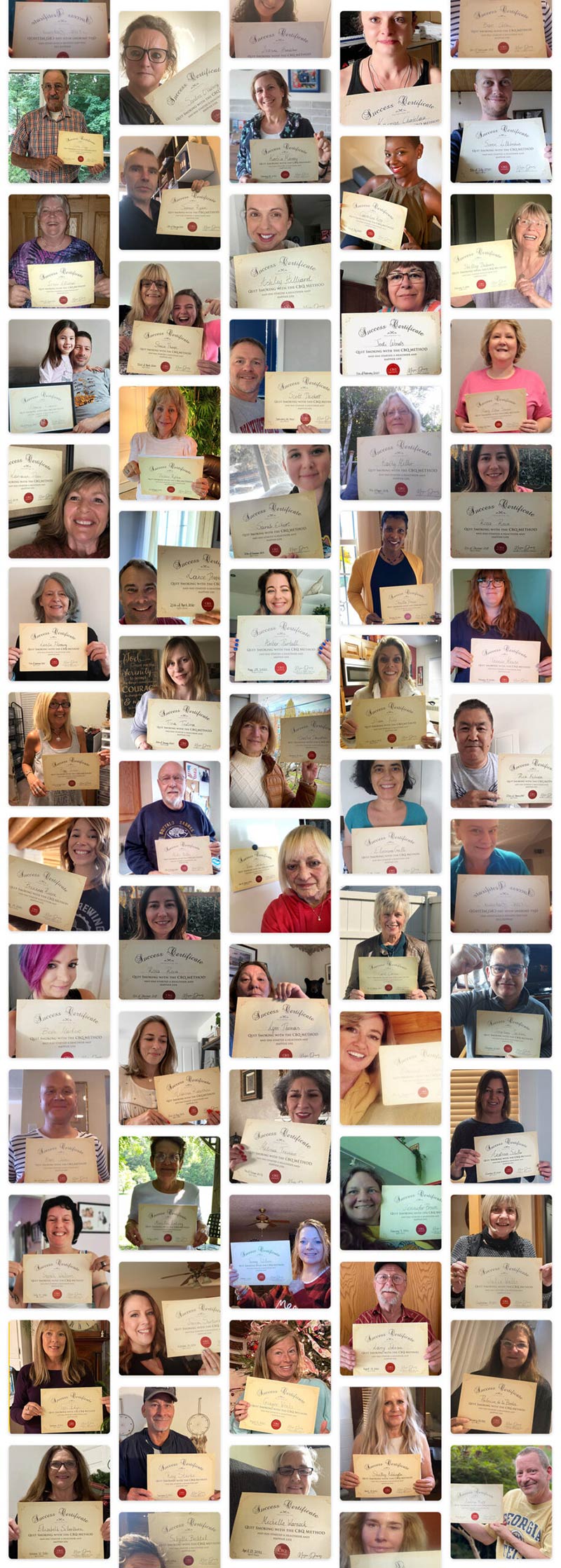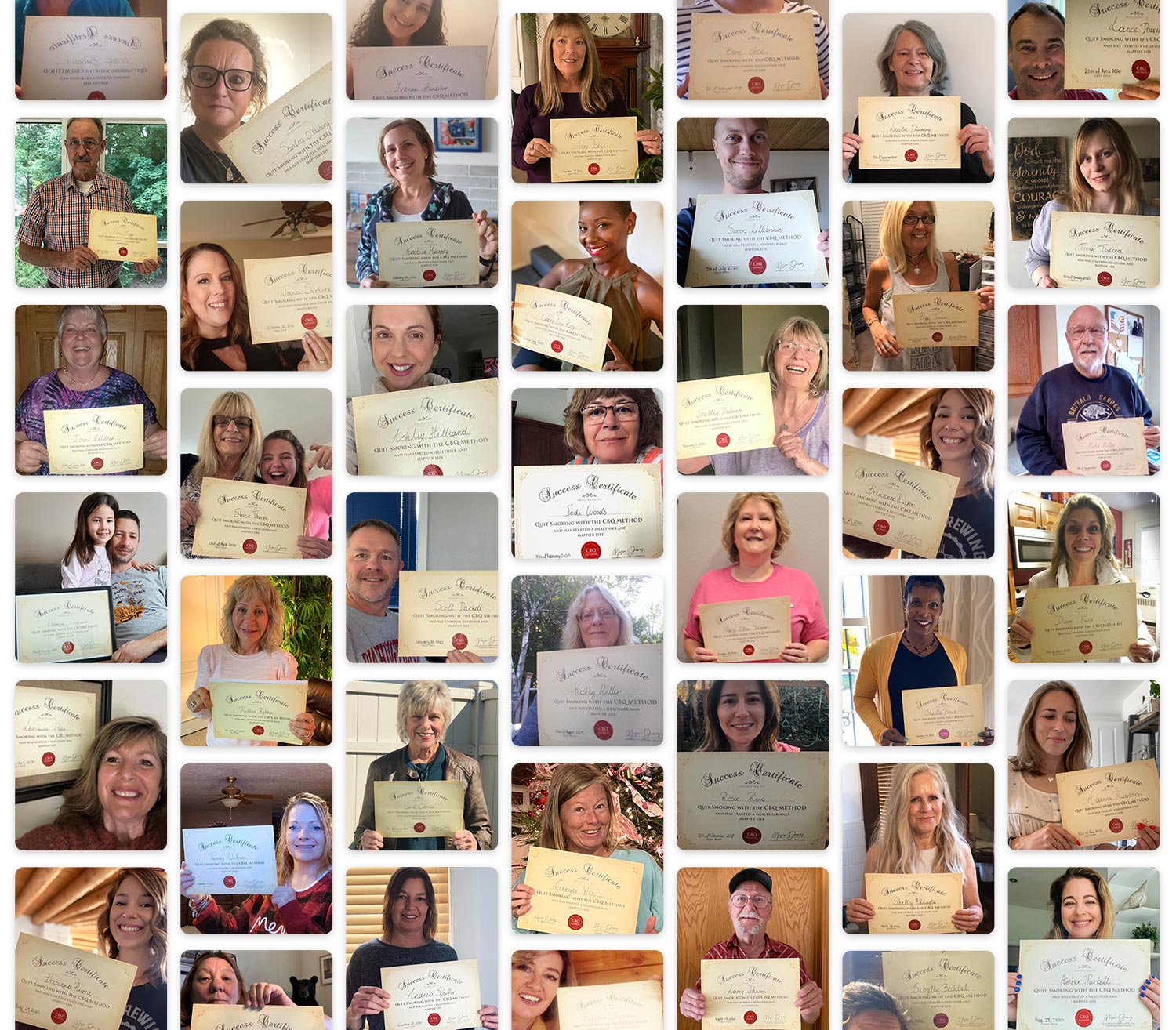When I was a smoker, I was constantly torn between my desire to stop smoking and my desire to smoke. I loved and hated smoking, often within the same breath.
One moment, I’d be convincing myself how much I enjoyed lighting up; ten minutes later, I’d be silently berating myself for not quitting. Deep down, I wanted nothing more than to be free of cigarettes, but achieving this seemed easier said than done.
Quitting smoking was like navigating through a wild, hostile forest without a map, trail, or protective equipment.
Even with two academic degrees in psychology, I always felt weak and hopeless.
I tried every quit-smoking approach, and I mean every single one, but every attempt ended with a cigarette between my fingers.
I tried things like:
And I experienced intense cravings and unbearable withdrawals that made me feel physically ill.
The more I tried to quit, the more I smoked. I’d started to accept I was a lost cause.
But that all changed when I discovered the secret to quitting smoking easily.
A New Hope For Smokers
If you also feel you’ve tried everything but nothing seems to work, and you always struggle and end up smoking again, then what I’m going to share with you will give you a whole new perspective on what’s really going on and how you can finally break free.
After all, you made it here for a reason, and if my story sounded similar to your experience, then you’re in the right place.
My name is Nasia Davos. I’m a psychologist, author, certified life coach, and certified smoking cessation coach.
After struggling for years to quit, I discovered the secret to quitting smoking and how to become a truly happy non-smoker.
It turns out that quitting smoking can be really, really easy once you do it in the right way.
From what I discovered, I created a 4-step method based on cognitive behavioral science that made me quit smoking easily and without willpower. (It’s called the CBQ Method – more about this in a bit)
So it quickly became my mission to help others do the same.
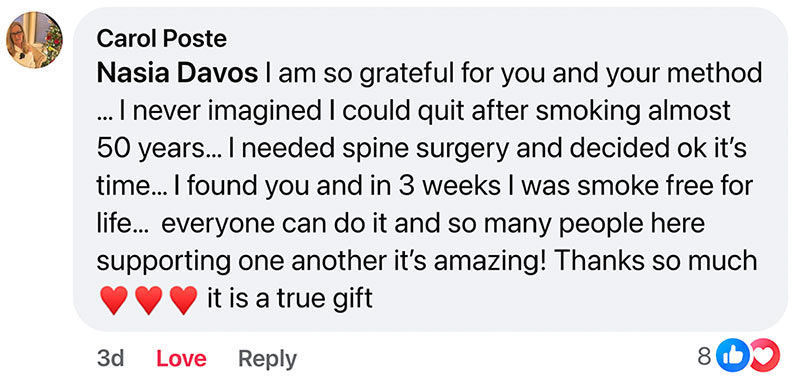
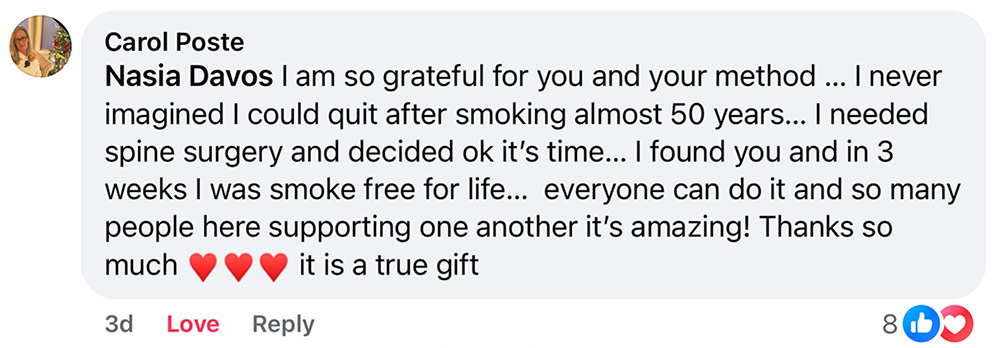
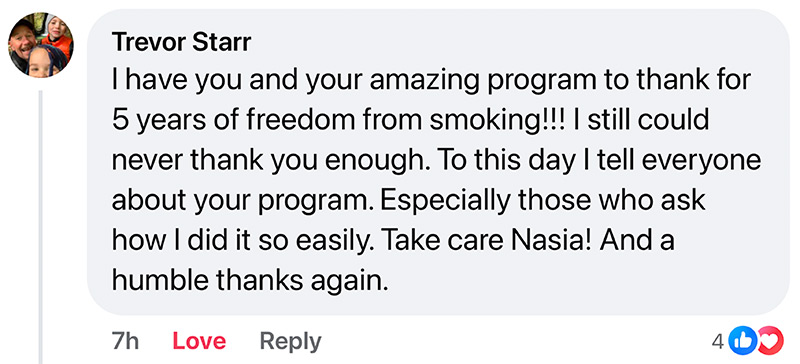

And over the last decade, my team and I have perfected this method that allowed me to help over 261,137 smokers succeed.
It’s been featured and recognized for helping even the most addicted smokers break free on:












…and many more!
This method has also been recognized by VeryWell Mind as the #1 best natural method to stop smoking and has won the Wellbeing Program Specialist of the Year Award for the last three years in a row.
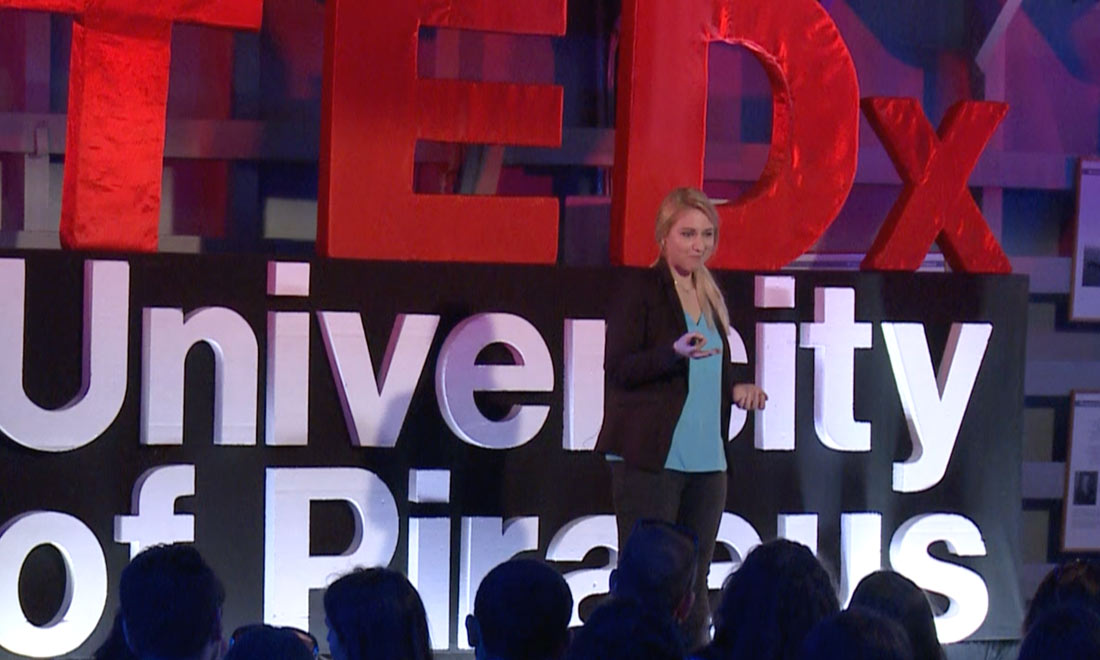
(Here’s a photo from my 2016 Ted Talk, viewed over 800,000 times, where I demonstrated my method to becoming a happy non-smoker)
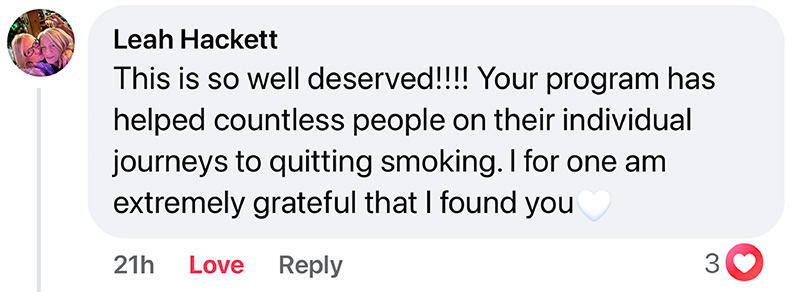

But I didn’t always know the secret to becoming a happy non-smoker. It was only after spending months researching and interviewing deprived ex-smokers and happy ex-smokers that I realized most people—including me—were trying to quit the wrong way!
The Truth about Nicotine Addiction
Most people believe quitting smoking is hard because they’re too addicted to nicotine. But the truth is, nicotine is a surprisingly weak substance. It has a short half-life, meaning half of the nicotine from your last cigarette leaves your body within two hours. And in 3 to 5 days without smoking, the nicotine has completely left your body.
So if you’ve ever quit for more than five days, you’ve already overcome the physical addiction.
If Nicotine Leaves So Quickly, Why Is Quitting Still So Hard?
Nicotine may disappear from your body in just a few days, but what keeps you going back to smoking and relapsing isn’t the physical addiction — it’s how deeply smoking is woven into your thoughts and daily life.
If the real problem was the physical addiction, you wouldn’t be able to sleep. Your physical cravings would jolt you awake every hour of the night just to smoke. But they don’t.
Just think about it. If you were to ask yourself why you lit up the last cigarette you smoked, or any other before that, your answers would be similar to these:
In fact, all the reasons we give ourselves for smoking are either psychological or habitual —not physical.
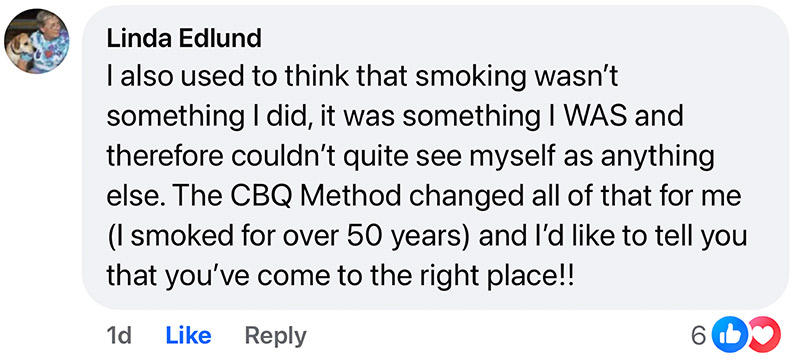
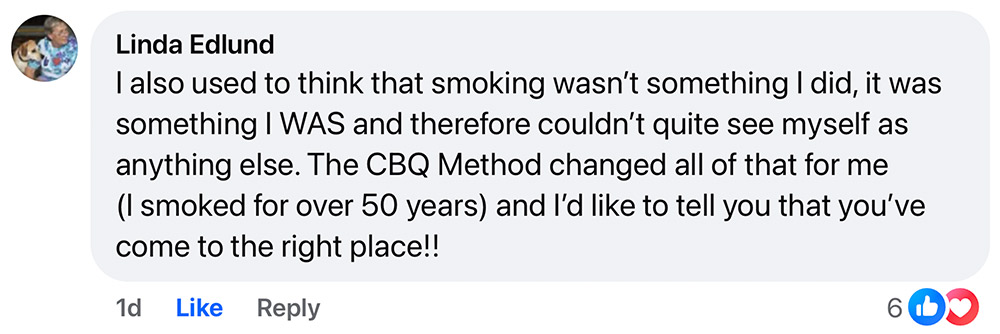
The Real Reason You Smoke
The truth is that smoking is not a physical addiction — it’s a mental and a behavioral addiction.
1. Cognitive (Psychological) Addiction
The cognitive or mental dependence is the strong relationship you’ve developed over the years with smoking. It is the psychological dependence that affects your thoughts and beliefs, and the emotional ties that you’ve built around cigarettes or vaping.
Maybe you believe smoking helps you cope with stress, boredom, or difficult feelings. You might enjoy the ritual or see it as a well-deserved reward. You may even hate smoking but still need “just one more” to feel normal.
These are all the ways mental dependence shows up in your life and causes you to miss smoking and experience irresistible cravings.
2. Behavioral Addiction
The behavioral dependence is all about when and how you smoke. It’s all the ways smoking has integrated throughout your day, your routine, and your life. This is what drives your automatic behavior when you reach for a cigarette with your morning coffee, after meals, during breaks at work, or whenever you feel restless.
When you started smoking, you gradually associated cigarettes with every aspect of your life, both the highs and the lows. You trained your brain to expect a cigarette when you talk on the phone, socialize, or want to reward yourself.
Now, all these situations have become triggers that remind you to smoke, and make you feel that life will be incomplete without nicotine.
The Only Solution
Smoking is only 10% a physical addiction and 90% mental and behavioral. So the reason you constantly feel the urge to smoke, have intense cravings, or find it impossible to quit is because your mental and behavioral dependence are still active.
So the only way to truly quit and never miss it again is to break the psychological and habitual chains that keep you attached to smoking.
Once you break these ties, you simply don’t want, need, or reach for a cigarette anymore— you’re truly free.
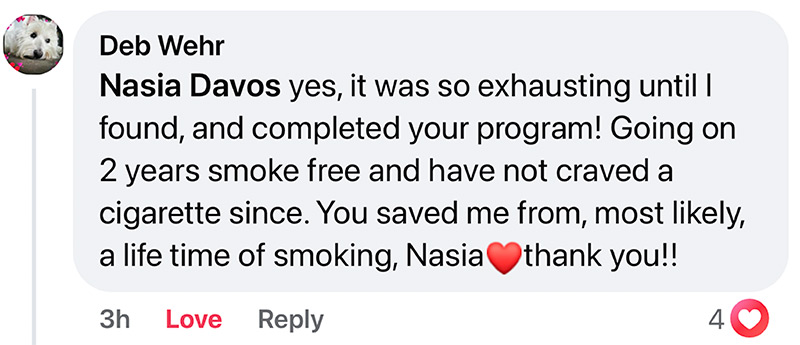

If the answer to quitting smoking is so simple, then why do so many people still struggle and relapse?
Why Most People Struggle: The Wrong Way to Quit Smoking
If you’ve tried to quit smoking before, you’ve probably tried all sorts of approaches like I did.
Patches, gums, willpower, hypnosis, cold turkey, pills, vaping, etc.
All these nicotine products being pushed on us do not target the real cause behind the smoking addiction. They do not target the mental aspect and the behavioral aspect of smoking. Not one bit.
No amount of nicotine patches, gums, lozenges, vaping, or pills can help you quit smoking because they focus on the physical aspect of your addiction, which goes away—anyway, and by itself—just 5 days after your last cigarette.
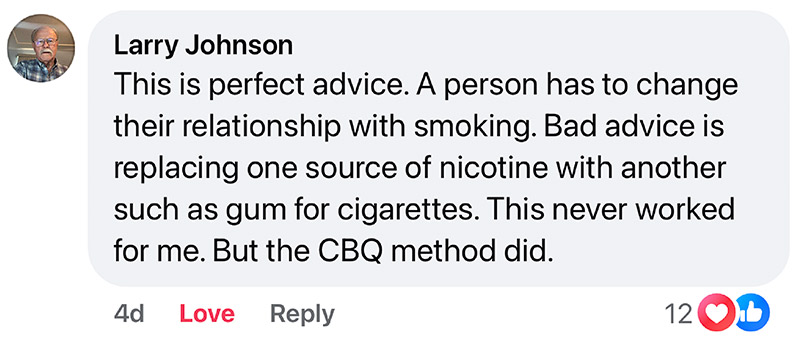

What about willpower then?
Resisting cigarettes with willpower or going cold turkey doesn’t target your mental and behavioral dependence either. It just puts you in a state of resistance, which makes you want to smoke more.
I used to think that if I resisted smoking long enough or listened to hypnosis tracks, somehow my desire would eventually go away. But all this time, I felt like an smoker who wasn’t allowed to smoke. I gained weight, lashed out, and felt unhappy… until I relapsed.
Because the mental and behavioral addiction do not fade away with time. That’s not how addictions work. Cravings only get stronger the longer you resist them with willpower.
So if you’ve failed countless times before, then please know that it’s not your fault. You’ve just been approaching it the wrong way.
The Good News
The good thing about addictions is that we’re not born with them. They are learned. You programmed your mind to rely on smoking as an inseparable part of your life.
Your mind is like a computer that runs many programs to help you do things quickly and automatically. Some programs are helpful, like driving, opening doors, writing, or walking, while other programs aren’t.
The mental and behavioral addiction to smoking is an unhelpful program you’ve been running for so long, it’s become automatic.
The good news is, you can unlearn that program, and reclaim your mind and your freedom.
And that’s exactly what the method I developed, which I call the CBQ Method, is designed to do: reprogram your mind back to that of a non-smoker.
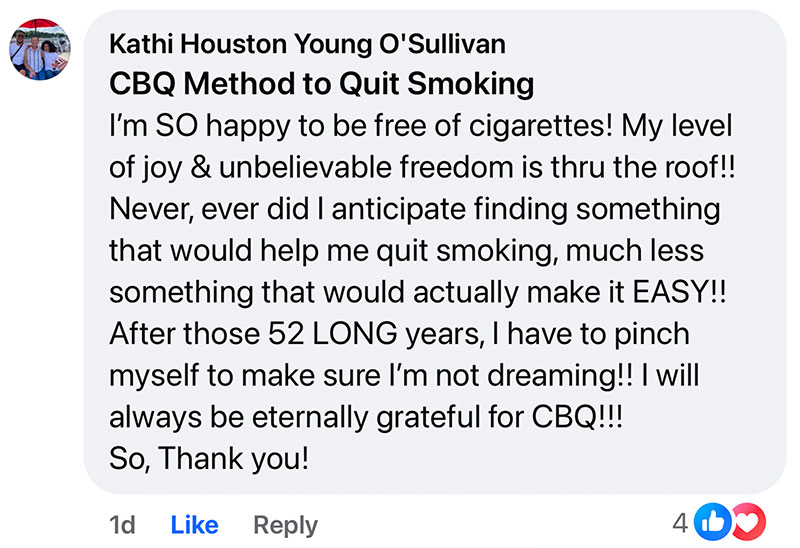

How the CBQ Method Reprograms Your Mind to Quit Smoking
CBQ stands for Cognitive Behavioral Quitting. The CBQ Method is a cognitive-behavioral approach designed to remove the psychological dependence on smoking and break a lifetime habit and addiction to nicotine.
During my research trying to figure out how to quit smoking, I interviewed many smokers, struggling ex-smokers, and happy ex-smokers. What I found is that all the happy ex-smokers had certain things in common, and it wasn’t how much they smoked, how stressful their lives were, or even how “ready” to quit they felt.
All ex-smokers who did not crave or miss cigarettes had unknowingly gone through 4 mental and behavioral steps.
I discovered that these 4 steps put together in a specific sequence made quitting smoking not only easy, but also inevitable.
And after following these 4 stages, I was able to help myself and others, quit smoking for good.
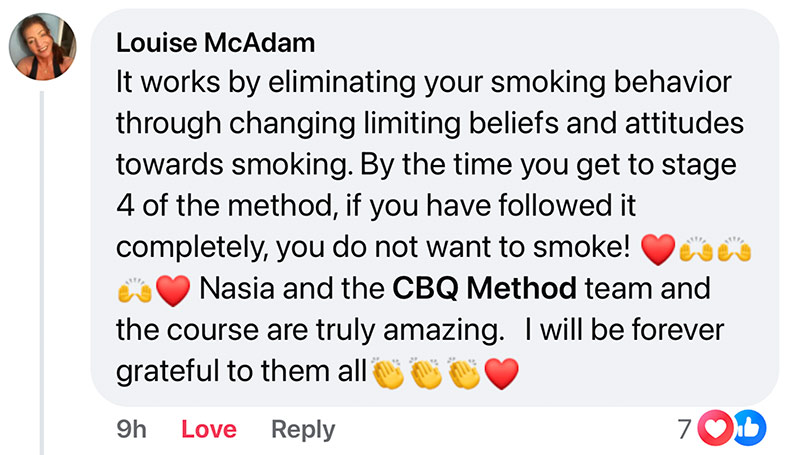
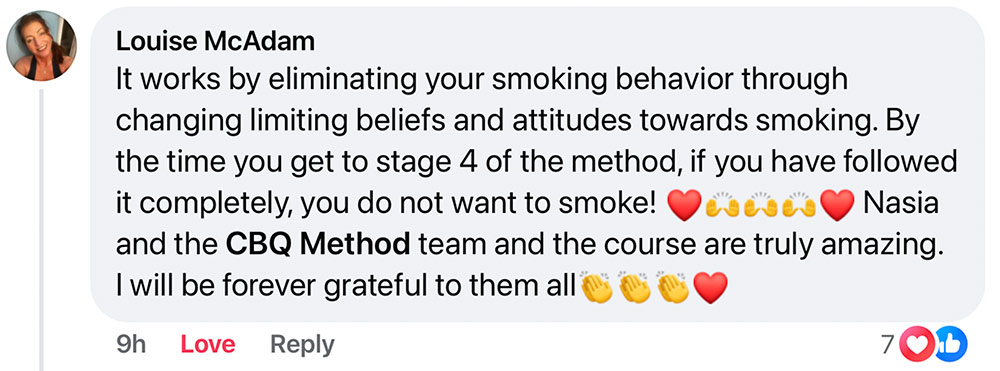
So I’ve put the 4 stages in a method that everyone can use to succeed. That method is the CBQ Method:
- Forever solution: No void left behind after quitting smoking
- Natural and free from medication or nicotine alternatives
- Scientifically reprograms your brain back to that of a non-smoker… in 4 steps.
Our members always tell us how surprisingly easy they find it to quit smoking, whether they’re light, moderate, or heavy smokers.


Now that you know why the CBQ Method works and why it makes quitting smoking easy, you might be wondering what the 4 stages of quitting smoking are and how to apply them to your own life so you can quit for good.
How to Quit Smoking Naturally, Starting Today
To show you how the CBQ Method can work for you, I’ve put together the “Step by Step Starter Guide of the CBQ Method.”
Getting it is free, and there are no strings attached.
In the free starter guide (video + workbook), you’ll discover:
- The 4 quit smoking stages and how to follow them so you can stop desiring cigarettes without using medication, substitutes, or “band-aids”
- What to do at each stage so you can reprogram your mind to quit smoking.
- Why the CBQ Method can work for you even if you’ve been smoking all your life, find quitting hard, and love cigarettes.
- The CBQ Method starter guide workbook with the outline of the 4 stages – plus tips, inspirational quotes, and notes you can use along your journey.
- And how you can apply the CBQ Method, starting today.
Click here to get the Starter Guide of the CBQ Method.
Right now, all you have to do is put your name and email address below to receive the CBQ Method starter guide in your inbox.
And if you’re tired of trying to quit and failing, there’s a special free gift waiting for you on the other side.
Thank you so much for being here with me and reading along.
See you soon,
Nasia Davos (MBPsS, IPPA, MA)
Creator of the CBQ Method™

P.S. In this free guide, I walk you through the 4 stages of the CBQ Method. You will learn how the CBQ Method works, what happens during each quit smoking stage, and how you can apply the 4 stages to your own life.
These are the exact 4 stages that have reached and helped millions of smokers quit for good.
Here are the smiling faces of some of the thousands of happy ex-smokers the CBQ Method has helped:
